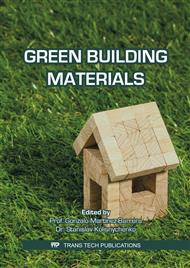[1]
Zhonglun ZHANG, Mingming WANG, Jing HE, Hongxia SHI and Zhijun XIN. Natural resource consumption and environmental load status analysis of main building construction materials industry in China [J]. Eco-city and Green Building, 2018 (01): 32-35.
Google Scholar
[2]
Hong YIN. Research on practice of clean production auditing in a certain cement production enterprise [D]. Heilongjiang University, (2018).
Google Scholar
[3]
Chengyang LI, Xianzheng GONG, Liwei ZHOU and Qing DING. Analysis of energy consumption and emission potential of cement industry in China [J]. China Building Materials Science & Technology, 2019, 28 (01): 21-24+18.
Google Scholar
[4]
Xu WANG. Analysis of carbon emissions reduction potential in production process of China's cement industry [J]. China Management Informationization, 2015, 18 (01): 117-121.
Google Scholar
[5]
Qi WU, Jingjing LIU, Juansheng LI, Ruilin MAN, Hong ZHANG and Qi LIU. Progress on the Application of solid waste in cement industry [J]. Modern Chemical Industry, 2015, 35 (01): 44-47.
Google Scholar
[6]
Lei TAO and Zhihe ZHANG. Current situation and development trend of PVC industry in China [J]. Polyvinyl Chloride, 2016, 44(7): 1-4.
Google Scholar
[7]
Yuyi LIU, Che-Way CHANG, Abdoullah Namdar, Yuexin SHE, Chen-Hua LIN, Xiang YUAN and Qin YANG. Stabilization of expansive soil using cementing material from rice husk ash and calcium carbide residue [J]. Construction and Building Materials, 2019, 221.
DOI: 10.1016/j.conbuildmat.2019.05.157
Google Scholar
[8]
Pengfei ZHOU, Hanrui PING, Fang ZHANG, Kai SUN and Mengmeng ZHANG. Research on the technology of developing circular economy with solid waste - calcium carbide slag [J]. Chemical Enterprise Management, 2019 (17): 176-177.
Google Scholar
[9]
Jing LIU and Wei WANG. Instance analysis on application of alternative materials to reduce CO2 emissions from cement industry [J]. New Building Materials, 2017, 44 (07): 97-99+118.
Google Scholar
[10]
Xuejun ZHAO, Zhenjun YANG, Xinwei LIN, Hao MA and Wenhui SHEN. Development status of comprehensive utilization of carbide slag [J]. China Chlor-Alkali, 2016 (07): 43-47.
Google Scholar
[11]
Qisheng DING, Genhua TANG and Shubiao LU. New technology for producing cement clinker using calcium carbide instead of limestone [J]. Cement Guide for New Epoch, 2007 (01): 10-14.
Google Scholar
[12]
Liang LI, Jindong BI, Yuwen BAI and Changyong LI. Study on calcination and clinkerization differences between raw meal with carbide slag proportion and ordinary raw meal [J]. Cement Guide for New Epoch, 2013, 19 (03): 18-21+84.
Google Scholar
[13]
Yunfeng ZHOU and Yixiang JI. Calcium carbide slag and its utilization in cement production [J]. Conservation and Utilization of Mineral Resources, 1993 (01): 51-53.
Google Scholar
[14]
Huageng CHEN. Alternatives for cement production by calcium carbide sludge [J]. Chemical Engineering Design, 2005 (02): 17-20+1.
Google Scholar
[15]
Qizhong XIAO, Hongjian ZHOU and Dongmei CUI. A new idea of producing cement with calcium carbide sludge [J]. Cement Engineering, 2008 (06): 72-76.
Google Scholar
[16]
Pinghong ZHANG, Ming ZHOU, Dalai ZHU and Ping XUE. First successful application of calcium carbide sludge on new dry milling and dry firing process cement line [J]. Cement Engineering, 2004 (03): 71-74.
Google Scholar
[17]
Yan ZHAO and Ping WEN. Design of 2000t/d cement production line with calcium carbide slag as raw material [J]. China Cement, 2017 (09): 79-83.
Google Scholar
[18]
Liwei HAO. Discussion on the production technology of cement using carbide slag as material in a new dry process kiln [A]. Institute of Technical Information for Building Materials Industry, Engineering Technology Subcommittee of China Silicate Society. 2016 China cement technology annual conference proceedings [C]. Institute of Technical Information for Building Materials Industry, Engineering Technology Subcommittee of China Silicate Society: China Silicate Society, 2016: 10.
DOI: 10.30919/esee8c930
Google Scholar



